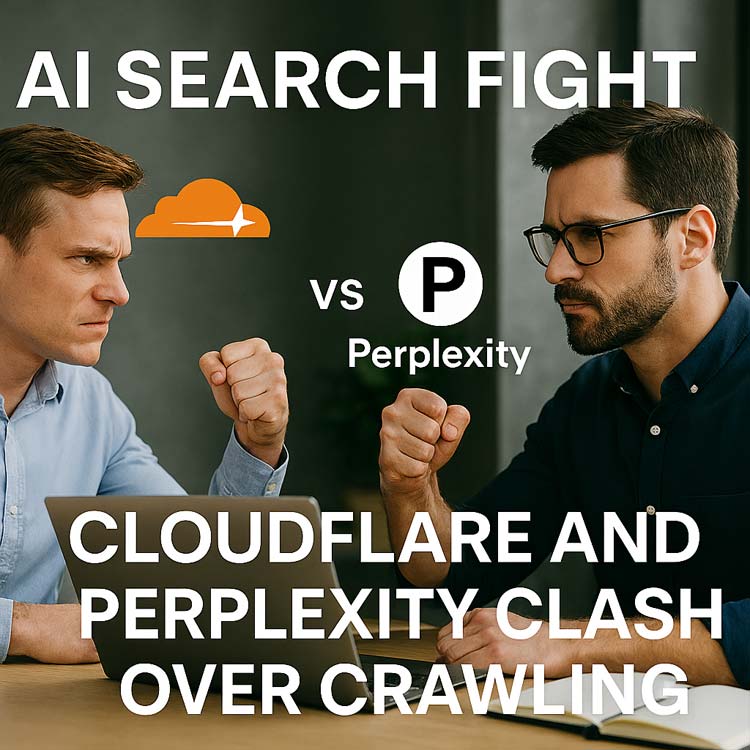The High-Stakes War Between AI Search Engines and Web Infrastructure
Introduction
As artificial intelligence rapidly reshapes the web, a new battlefield has emerged — AI crawlers vs. publishers. In a dramatic faceoff, Cloudflare, one of the largest internet infrastructure providers, accused AI search company Perplexity of using stealth crawling tactics to access web content against publisher instructions. This dispute sends ripples through the SEO, digital publishing, and AI industries.
In this in-depth post, we’ll explore:
- The background behind the conflict
- Technical details about crawling and content access
- SEO and legal implications for publishers
- Best practices to defend your content
- Internal tools to manage crawler compliance
- FAQs and predictions for the future of SEO in the AI age
If you’re a publisher, SEO expert, or digital strategist, this is your essential briefing.
🔍 1. Who Are Cloudflare and Perplexity?
Before diving into the dispute, let’s define the players:
Cloudflare
Cloudflare is a web performance and security company that powers around 20% of the internet. They provide:
- DDoS protection
- CDN services
- Website firewall rules
- Bot protection and traffic filtering
- Verified crawler programs
Cloudflare recently introduced new features that help websites block, allow, or monetize AI crawlers.
Perplexity AI
Perplexity is a next-gen AI-powered search engine that delivers real-time answers by summarizing web content using LLMs (large language models). It’s often compared to ChatGPT but with real-time web citations.
The core of Perplexity’s model depends on fetching and analyzing web pages. And that’s exactly where the controversy lies.
⚔️ 2. The Conflict: Allegations of Stealth Crawling
Cloudflare published a detailed report claiming that Perplexity is bypassing web publishers’ rules by:
- Accessing content explicitly disallowed via robots.txt
- Masking its bot identity by using generic user-agents (e.g. Chrome)
- Using rotating IP addresses and ASNs not listed in its documentation
- Continuing access even after publishers blocked PerplexityBot
Cloudflare used test websites, fake links, and access logs to show Perplexity’s systems visited them even when no permission was given. In their view, this behavior violates internet standards and transparency.
🎯 3. What is Stealth Crawling?
Stealth crawling refers to cloaked or disguised bot activity. Instead of declaring themselves as bots, stealth crawlers:
- Use normal browser user-agents to appear human
- Route requests through residential IPs
- Avoid detection by anti-bot systems
- Ignore crawling rules like robots.txt
These techniques are typically associated with hackers, ad fraud bots, or scrapers — not reputable AI companies.
This is what Cloudflare accuses Perplexity of doing: disguising its crawler to fetch content without consent.
🧑⚖️ 4. Perplexity’s Response
Perplexity rejected the allegations, saying:
- Their system only fetches pages in response to user-initiated queries
- They respect robots.txt and opt-out requests
- Any behavior Cloudflare detected may be due to third-party tools or browser rendering services used to display content properly
- They are not mass crawling like traditional search engines
Perplexity argues that it’s no different than a user reading a website and sharing it with others using AI assistance.
🌐 5. The Bigger Problem: AI vs. the Open Web
This isn’t just a one-off squabble. It reflects a growing tension between:
- Publishers, who want to protect their content and monetize it
- AI companies, who need web data to train models and answer questions
- SEO professionals, who depend on search engine indexing and fair web rules
Key issues include:
- Loss of traffic: If AI tools summarize your content, users might not visit your website.
- Violation of terms: AI companies using content in ways you didn’t authorize.
- No fair exchange: Content is taken, but no backlinks, credit, or ad revenue is returned.
- Legal gray areas: Is this “fair use,” or does it break copyright laws?
📉 6. SEO Impacts for Publishers and Marketers
Decreased Organic Clicks
As AI search assistants grow, click-through rates from search results may drop. Users get their answers directly from AI interfaces — with no need to click to your site.
Attribution and Branding Loss
If AI doesn’t credit or link to you properly, you lose brand exposure and potential backlinks. Your content becomes anonymous training data.
Indexing Disruption
Stealth bots often ignore robots.txt — but may still get your pages indexed in ways that distort SEO signals or cause content duplication.
Content Devaluation
When your content is summarized without consent, its original value to users (and search engines) may shrink.

🛡️ 7. How to Protect Your Content from AI Crawlers
Here are practical actions you can take right now:
1. Optimize Your Robots.txt File
Disallow known AI crawlers by name. Example:
makefileCopyEditUser-agent: PerplexityBot
Disallow: /
2. Use Meta Tags to Prevent Reuse
Include <meta name="robots" content="noai"> or similar tags if you want to prevent your content from being used by AI models (when supported).
3. Use WAF Rules
Platforms like Cloudflare allow you to create bot firewall rules, blocking:
- Suspicious IP ranges
- Bot-like behavior
- Fake Chrome user-agents
4. Monitor Logs for Stealth Access
Check for:
- IPs with high access rates but no browser headers
- User-agents that mimic Chrome or Safari
- Access outside of normal hours or geographies
5. Add a Crawl Policy in Your Terms of Use
Make it clear that AI systems or bots must respect your crawling rules, and unauthorized scraping violates your content license.
🧰 8. Internal Link
Want to know if your site is vulnerable to unauthorized AI crawling? Run a complete SEO crawl audit to:
- Check your robots.txt setup
- Monitor indexed pages
- Detect suspicious crawlers
- Improve server security
👉 Use the SEO Audit Tool on Small-SEO-Tool.com
9. FAQs
Q1: What is the robots.txt file?
robots.txt is a file that tells crawlers which pages they’re allowed or disallowed from accessing. It’s a standard used by ethical bots like Google, Bing, etc.
Q2: Are AI search engines like Perplexity the same as Google?
No. Traditional search engines follow strict web protocols and link back to sources. Many AI tools summarize content without sending clicks back, and may not follow crawl rules.
Q3: Can I legally block AI from using my content?
The law is still evolving, but you can disallow access via technical and contractual measures. You should also include clear licensing and usage terms on your site.
Q4: How can I check if stealth crawlers are accessing my website?
You can monitor access logs, filter by suspicious user-agents, and track traffic spikes. Tools like our SEO Audit Tool can help identify stealth activity.
Cloudflare Perplexity clash, AI web crawling, stealth bots, robots.txt SEO, content scraping, AI search engines, SEO protection tools, AI content control
Q5: Is blocking AI crawlers bad for SEO?
Blocking some AI bots won’t hurt your rankings — but be careful not to block legitimate search engines like Googlebot. Target only unwanted AI crawlers.
A Defining Battle in the Future of Search
The Cloudflare vs. Perplexity clash marks a turning point in how the web interacts with AI-powered search tools.
Publishers and SEO professionals must:
- Understand their rights
- Take technical steps to control content access
- Monitor who uses their data
- Adapt strategies to balance visibility and protection
This fight isn’t just about two companies — it’s about how every website owner, marketer, and content creator will thrive or struggle in the AI-driven future of the internet.
Need help identifying crawler behavior or optimizing your site’s defense?
👉 Try our SEO Audit Tool for instant crawl diagnostics, visibility insights, and protection tips.



